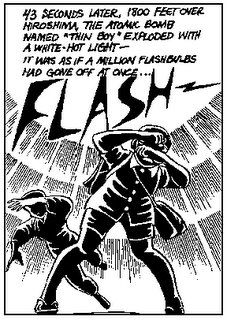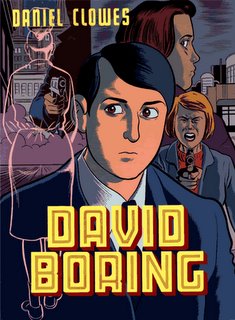 I just stumbled across MonkStyle.net, the website of Aaron Booth, a Sydney, Australia-based web designer that was trained as an illustrator at Joe Kubert's renowned World of Cartooning (NYC). In addition to the expected ranting and comic book musings, his blog contains links to his eye-catching drawings and photographs.
I just stumbled across MonkStyle.net, the website of Aaron Booth, a Sydney, Australia-based web designer that was trained as an illustrator at Joe Kubert's renowned World of Cartooning (NYC). In addition to the expected ranting and comic book musings, his blog contains links to his eye-catching drawings and photographs.Some of the art is suprisingly amateurish considering his training (not bad, just a little flat) -- but a great deal of the newer material is staggeringly good, especially his Flash/Illustrator work that transforms mundane photogaphs into vector images that rival the best comic book artistry I've ever seen (and I've seen oodles, let me tell ya).
Booth (aka Dr. Snafu) is particularly apt at capturing a sense of emotion in the silent pauses and glimmering eyes of his portraits. If he can sustain this level of quality over the course of sequential panels and action sequences -- and mix in some delicious backgrounds -- then illustration wunderkinds such as Josh Middleton and John Cassaday will have a run for their pencils. Do yourself a favor and visit his site for more sumptuous visuals. Or go directly to his Flickr gallery.


(The images above are copyright Dr. Snafu; the other images on this page are copyright their respective owners.)
***
 As recently hyped by Wired magazine, Star Trek: New Voyages will be releasing a new Star Trek episode soon. This one staring Walter Koenig, the original Lt. Pavel Chekov. It's amateur fan-boy TV-show freak-out time, as the New Voyage kids finally have one of the real Star Trek actors acting alongside their hazy facsimile versions of Kirk, Spock, and crew.
As recently hyped by Wired magazine, Star Trek: New Voyages will be releasing a new Star Trek episode soon. This one staring Walter Koenig, the original Lt. Pavel Chekov. It's amateur fan-boy TV-show freak-out time, as the New Voyage kids finally have one of the real Star Trek actors acting alongside their hazy facsimile versions of Kirk, Spock, and crew.***

I finally got around to reading the first volume of Keiji Nakazawa's Barefoot Gen: A Cartoon Story of Hiroshima, which was excellent.

Jason Lute's sublime Jar of Fools: A Picture Story and Dan "Ghost World" Clowes' suprising, twisting David Boring were also mind-blowingly superb. And Kyle Baker's Plastic Man: On the Lam! was a wacky, Plaztastic
 However, Rick Veitch's Maximortal and Brat Pack graphic novels (the first two volumes of the as yet uncompleted King Hell Heroica five-part series) were not as mesmerizing as I'd hoped. Interesting, provocative, gross-out funny, and weird, yes. But not the best revisionist superhero epic in the galaxy (Veitch has had his hand in quite a few classics over the years, notably as an artist, but his solo works never quite reach the pinnacle of such superhero reimaginings as Planetary, the Invisibles, Watchmen, X-Statix, Miracle Man, Sandman, the best of Frank Miller and Alan Moore, even such oddities as American Flagg, Nexus, Zot!, Madman, Concrete, etcetera, etcetera). Brat Pack does offer lush black-white-and-grey artwork, the creepiest interpretation of Batman & Robin you'll ever read, the iconic/archetypal Doctor Blasphemy (one of the most memorable-looking comic creations ever), and the catchy tagline, "Live fast, love hard, die with your mask on."
However, Rick Veitch's Maximortal and Brat Pack graphic novels (the first two volumes of the as yet uncompleted King Hell Heroica five-part series) were not as mesmerizing as I'd hoped. Interesting, provocative, gross-out funny, and weird, yes. But not the best revisionist superhero epic in the galaxy (Veitch has had his hand in quite a few classics over the years, notably as an artist, but his solo works never quite reach the pinnacle of such superhero reimaginings as Planetary, the Invisibles, Watchmen, X-Statix, Miracle Man, Sandman, the best of Frank Miller and Alan Moore, even such oddities as American Flagg, Nexus, Zot!, Madman, Concrete, etcetera, etcetera). Brat Pack does offer lush black-white-and-grey artwork, the creepiest interpretation of Batman & Robin you'll ever read, the iconic/archetypal Doctor Blasphemy (one of the most memorable-looking comic creations ever), and the catchy tagline, "Live fast, love hard, die with your mask on."And storywise Maximortal and Brat Pack tie together nicely while also seemingly forming the backdrop for exciting things to come. But overall the scripting can feel a bit hamhanded and rushed, wallowing in its own dirty jokes and contrivances while never living up to the best ideas and images presented. Maximortal
***
Designer Mark Wasserman is Plinko. Plinko is cool. And funny.
Also worth a look is X-Ray Spex, the blog of comics writer/newspaper man Will Pfeifer, "Promising penetrating insight, delivering cheap cardboard glasses"
***

The Sci Fi Channel's online Seeing Ear Theatre has some great new radio-style audio dramas up, like Bebe Neuwirth reading the part of the Queen in Neil "Sandman" Gaiman's Snow Glass Apples.
And 4ColorHeroes offers a ton of links to free, super-rare Alan "Watchmen" Moore online goodies, including lost comics, scripts, MP3s, interviews, prose, and essays.





